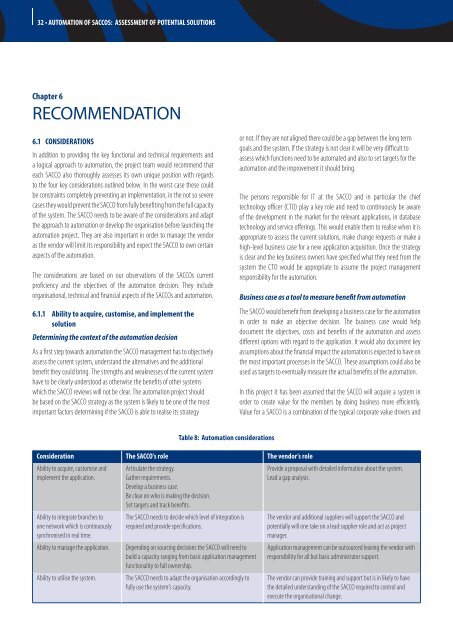Automation of SACCOs - FSD Kenya
Automation of SACCOs - FSD Kenya
Automation of SACCOs - FSD Kenya
Create successful ePaper yourself
Turn your PDF publications into a flip-book with our unique Google optimized e-Paper software.
32 • AUTOMATION OF SACCOS: ASSESSMENT OF POTENTIAL SOLUTIONS<br />
Chapter 6<br />
reCommenDAtion<br />
6.1 ConSIDErATIonS<br />
In addition to providing the key functional and technical requirements and<br />
a logical approach to automation, the project team would recommend that<br />
each SACCO also thoroughly assesses its own unique position with regards<br />
to the four key considerations outlined below. In the worst case these could<br />
be constraints completely preventing an implementation, in the not so severe<br />
cases they would prevent the SACCO from fully benefiting from the full capacity<br />
<strong>of</strong> the system. The SACCO needs to be aware <strong>of</strong> the considerations and adapt<br />
the approach to automation or develop the organisation before launching the<br />
automation project. They are also important in order to manage the vendor<br />
as the vendor will limit its responsibility and expect the SACCO to own certain<br />
aspects <strong>of</strong> the automation.<br />
The considerations are based on our observations <strong>of</strong> the <strong>SACCOs</strong> current<br />
pr<strong>of</strong>iciency and the objectives <strong>of</strong> the automation decision. They include<br />
organisational, technical and financial aspects <strong>of</strong> the <strong>SACCOs</strong> and automation.<br />
6.1.1 Ability to acquire, customise, and implement the<br />
solution<br />
Determining the context <strong>of</strong> the automation decision<br />
As a first step towards automation the SACCO management has to objectively<br />
assess the current system, understand the alternatives and the additional<br />
benefit they could bring. The strengths and weaknesses <strong>of</strong> the current system<br />
have to be clearly understood as otherwise the benefits <strong>of</strong> other systems<br />
which the SACCO reviews will not be clear. The automation project should<br />
be based on the SACCO strategy as the system is likely to be one <strong>of</strong> the most<br />
important factors determining if the SACCO is able to realise its strategy<br />
Consideration The SACCo’s role The vendor’s role<br />
Ability to acquire, customise and<br />
implement the application.<br />
Ability to integrate branches to<br />
one network which is continuously<br />
synchronised in real time.<br />
Table 8: <strong>Automation</strong> considerations<br />
Articulate the strategy.<br />
Gather requirements.<br />
Develop a business case.<br />
Be clear on who is making the decision.<br />
Set targets and track benefits.<br />
The SACCO needs to decide which level <strong>of</strong> integration is<br />
required and provide specifications.<br />
Ability to manage the application. Depending on sourcing decisions the SACCO will need to<br />
build a capacity ranging from basic application management<br />
functionality to full ownership.<br />
Ability to utilise the system. The SACCO needs to adapt the organisation accordingly to<br />
fully use the system’s capacity.<br />
or not. If they are not aligned there could be a gap between the long term<br />
goals and the system. If the strategy is not clear it will be very difficult to<br />
assess which functions need to be automated and also to set targets for the<br />
automation and the improvement it should bring.<br />
The persons responsible for IT at the SACCO and in particular the chief<br />
technology <strong>of</strong>ficer (CTO) play a key role and need to continuously be aware<br />
<strong>of</strong> the development in the market for the relevant applications, in database<br />
technology and service <strong>of</strong>ferings. This would enable them to realise when it is<br />
appropriate to assess the current solutions, make change requests or make a<br />
high-level business case for a new application acquisition. Once the strategy<br />
is clear and the key business owners have specified what they need from the<br />
system the CTO would be appropriate to assume the project management<br />
responsibility for the automation.<br />
Business case as a tool to measure benefit from automation<br />
The SACCO would benefit from developing a business case for the automation<br />
in order to make an objective decision. The business case would help<br />
document the objectives, costs and benefits <strong>of</strong> the automation and assess<br />
different options with regard to the application. It would also document key<br />
assumptions about the financial impact the automation is expected to have on<br />
the most important processes in the SACCO. These assumptions could also be<br />
used as targets to eventually measure the actual benefits <strong>of</strong> the automation.<br />
In this project it has been assumed that the SACCO will acquire a system in<br />
order to create value for the members by doing business more efficiently.<br />
Value for a SACCO is a combination <strong>of</strong> the typical corporate value drivers and<br />
Provide a proposal with detailed information about the system.<br />
Lead a gap analysis.<br />
The vendor and additional suppliers will support the SACCO and<br />
potentially will one take on a lead supplier role and act as project<br />
manager.<br />
Application management can be outsourced leaving the vendor with<br />
responsibility for all but basic administrator support.<br />
The vendor can provide training and support but is in likely to have<br />
the detailed understanding <strong>of</strong> the SACCO required to control and<br />
execute the organisational change.
















